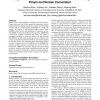11 search results - page 2 / 3 » Semi-formal Evaluation of Conversational Characters |
BIRTHDAY
2009
Springer
13 years 11 months ago
2009
Springer
Conversational dialogue systems cannot be evaluated in a fully formal manner, because dialogue is heavily dependent on context and current dialogue theory is not precise enough to ...
IVA
2010
Springer
13 years 3 months ago
2010
Springer
Conversational modeling requires an extended time commitment, and the difficulty associated with capturing the wide range of conversational stimuli necessitates extended user parti...
ICASSP
2011
IEEE
12 years 8 months ago
2011
IEEE
This paper describes recent advances at LIMSI in Mandarin Chinese speech-to-text transcription. A number of novel approaches were introduced in the different system components. Th...
CIKM
2007
Springer
13 years 8 months ago
2007
Springer
Hidden markov model (HMM) is frequently used for Pinyin-toChinese conversion. But it only captures the dependency with the preceding character. Higher order markov models can brin...
MAGS
2008
13 years 4 months ago
2008
Embodied Conversational Agents (ECAs) are computer generated life-like characters that interact with human users in face-to-face conversations. To achieve natural multi-modal conve...


